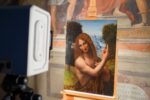Bianco-Valente – Campo visivo
, 2013 (1200x799).jpg)
Bianco-Valente presentano un progetto espressamente pensato per lo spazio fiorentino, un lavoro scaturito dall’osservazione delle relazioni tra le persone, e tra queste e i luoghi e i linguaggi.
Comunicato stampa
Bianco-Valente presentano un progetto espressamente pensato per lo spazio fiorentino, un lavoro scaturito dall’osservazione delle relazioni tra le persone, e tra queste e i luoghi e i linguaggi. Gli studenti della Srisa e i giovani artisti attivi a Firenze saranno coinvolti, come autori e vettori, in un’indagine sulla visione e sulla sua traduzione: un viaggio nell’immagine come metalinguaggio.
Le opere del duo artistico nascono sempre come sintesi di un processo interrogante, che si irradia dagli autori per coinvolgere diversi interlocutori, lo spazio, gli strumenti di rappresentazione e i dispositivi di identificazione e di riconoscimento dell’appartenenza. In forza di questa vocazione tutti i loro lavori, anche quelli più formalmente compiuti, mantengono il profilo della stratificazione che li ha creati, e lasciano leggere la complessità di sguardi e di azioni che sono intervenuti nella loro composizione. Che si tratti di mappe, di narrazioni visive e verbali, di interventi fisici sull’architettura e sul paesaggio, Bianco-Valente agiscono seguendo un minuzioso percorso di riscrittura, sotto la pelle delle cose e molto più in là della loro superficie.
Bianco-Valente
Mappe temporanee (Temporary maps)
Campo Visivo, “field of vision”, explores our visual horizon and questions what lies beyond it. The investigation doesn’t define the boundary but tests the frailty of its interpretive value; it is this search that helps us understand the connection between our visual horizon and what lies beyond it. The tools used to investigate this link are both visual and verbal.
The “campo visivo”, “field of vision” (visual horizon) refers to the original images that began the process of interpretation. It is the content of these images and more importantly the complex journey that brought these images into the hands of the artists that is of significance to the process of interpretation.
The visual landscape is fractured into braches and revisions that cover the walls of the exhibition space. In sprawling succession, the alternation of the text and images painted in watercolor, distend over the space obscuring further and further the original images until there is nothing left but the thread that binds them. These new images are bound to the original in a necessary evolution that ponders the visual multiplicity inherent in each of the original image. The visual landscape is a map, a constellation, of those temporary relationships of which they are the sum.
The authors of this metalinguistic journey are the artists and students. The project was developed expressly for the SRISA exhibition and brought in the participation of the student and staff of the school as well as the young Florentine artists, friends, scholars and established artists in the community. Each participant was asked to either write a short passage describing one of the images or paintings or to paint a watercolor that illustrated the text that was given to them.
Pietro Gagliano’



